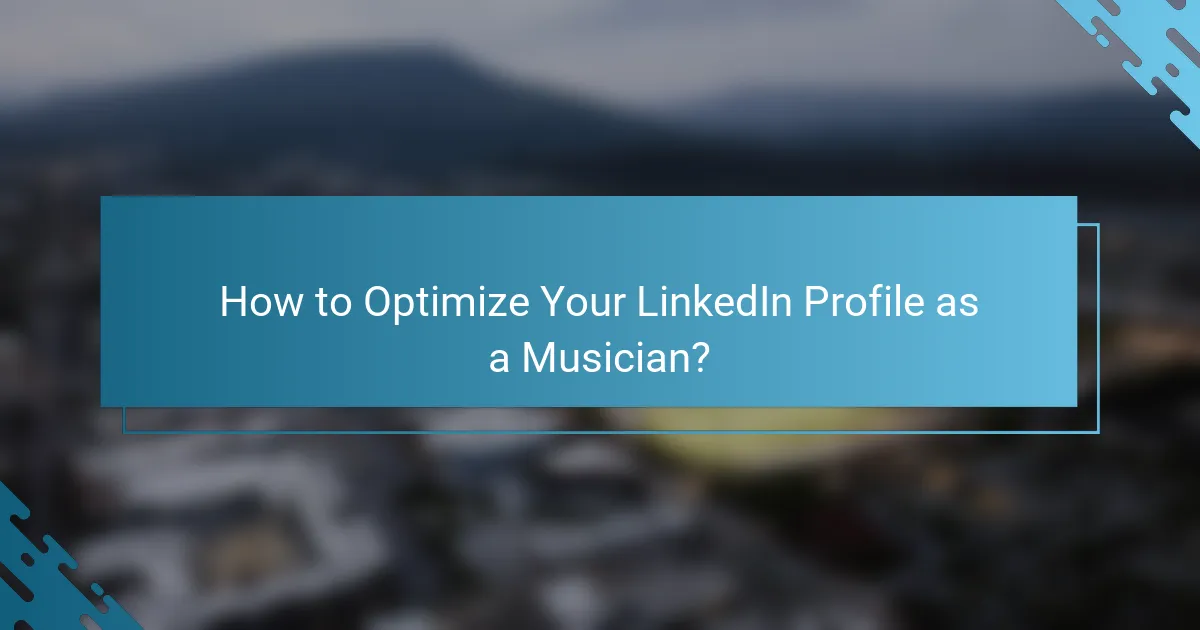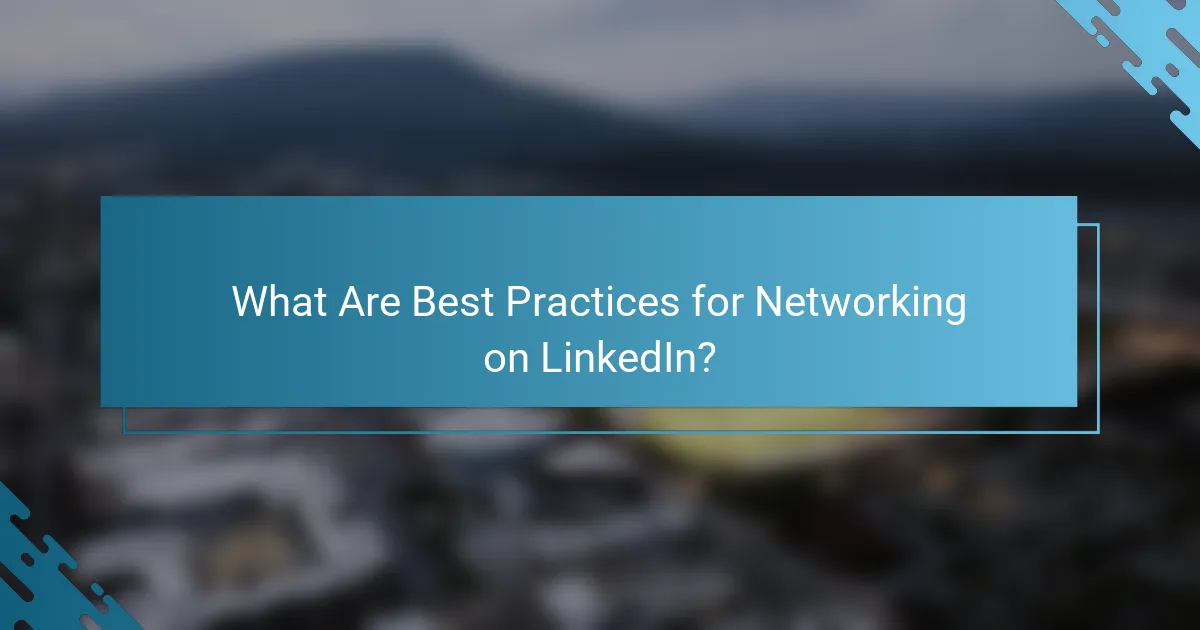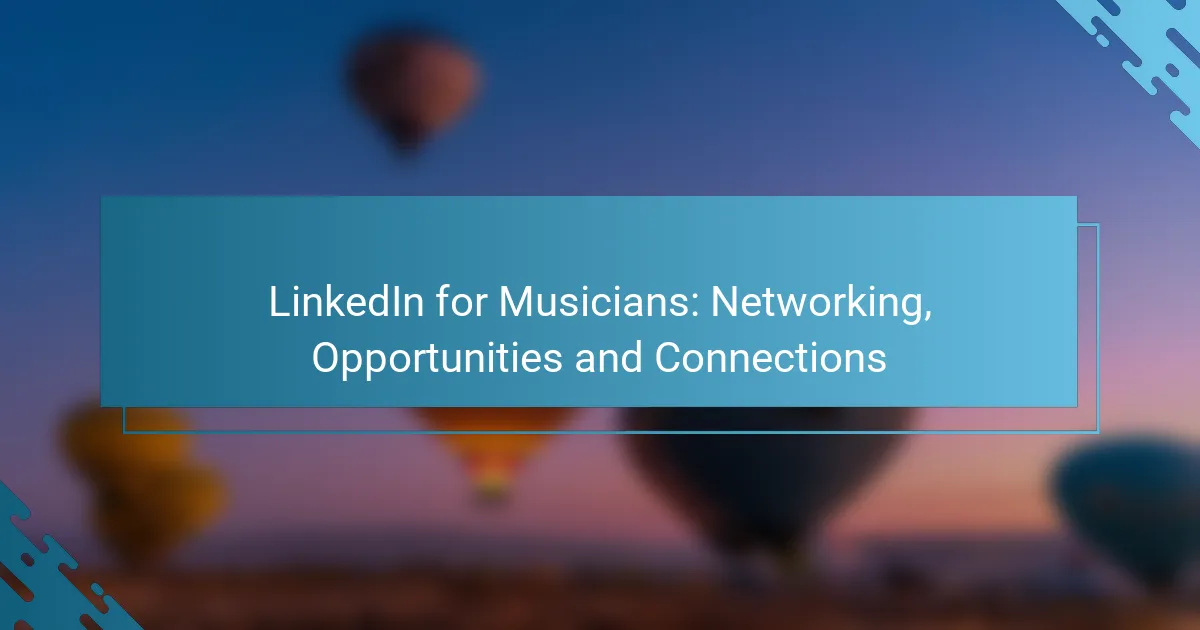LinkedIn offers musicians a powerful platform to build a professional presence and connect with industry professionals. By optimizing their profiles and engaging in relevant groups, musicians can showcase their talents, discover job opportunities, and foster valuable collaborations that can advance their careers.

How Can Musicians Leverage LinkedIn for Networking?
Musicians can effectively leverage LinkedIn for networking by creating a strong professional presence, connecting with industry professionals, and engaging in relevant groups. This platform offers unique opportunities to showcase talent and build relationships that can lead to collaborations and career advancements.
Building a professional profile
A well-crafted LinkedIn profile is essential for musicians looking to network. Start by using a professional photo and writing a compelling headline that reflects your musical identity and expertise. Include a detailed summary that highlights your experience, skills, and musical achievements.
Make sure to list your education, relevant work experience, and any notable performances or collaborations. Use keywords related to your genre and skills to enhance visibility in searches.
Connecting with industry professionals
Building connections with industry professionals is crucial for expanding your network. Begin by sending personalized connection requests to fellow musicians, producers, and music industry executives. Mention any mutual connections or shared interests to increase the likelihood of acceptance.
Regularly engage with your connections by liking, commenting, or sharing their posts. This not only strengthens relationships but also keeps you visible within your network.
Engaging in relevant groups
Joining LinkedIn groups related to music and the entertainment industry can provide valuable networking opportunities. Look for groups focused on your genre, music production, or artist promotion. Participate actively by sharing insights, asking questions, and contributing to discussions.
These groups often host events and discussions that can lead to collaborations or job opportunities, making them a vital resource for musicians.
Utilizing LinkedIn messaging
LinkedIn messaging is a powerful tool for direct communication with industry contacts. Use it to follow up after connecting or to introduce yourself to someone whose work you admire. Keep messages concise and professional, clearly stating your purpose.
Avoid generic messages; personalize your outreach by referencing specific projects or interests. This approach increases the chances of a positive response and fosters meaningful connections.
Showcasing music projects
Highlighting your music projects on LinkedIn can attract attention from potential collaborators and industry professionals. Use the ‘Featured’ section to showcase links to your music, videos, or articles about your work. This visual representation of your talent can make a strong impression.
Consider sharing updates about upcoming performances, releases, or collaborations in your posts. Regularly sharing content keeps your network informed and engaged with your musical journey.

What Opportunities Does LinkedIn Offer for Musicians?
LinkedIn provides musicians with a platform to connect with industry professionals, discover job openings, and collaborate on projects. By leveraging LinkedIn’s networking capabilities, musicians can enhance their visibility and access various opportunities within the music industry.
Job postings in the music industry
LinkedIn features numerous job postings specifically tailored for musicians, ranging from performance opportunities to roles in music production and management. Musicians can search for jobs by using relevant keywords and filters to narrow down their options based on location, experience level, and job type.
To maximize job search effectiveness, musicians should keep their profiles updated and tailored to the roles they are interested in. Engaging with industry-related content and following key companies can also increase visibility to potential employers.
Collaborative projects and partnerships
LinkedIn serves as a valuable resource for musicians seeking collaborative projects and partnerships. By connecting with other artists, producers, and industry professionals, musicians can explore opportunities to work together on new music, performances, or events.
Joining relevant groups and participating in discussions can help musicians find like-minded collaborators. Additionally, showcasing past work and skills on their profiles can attract potential partners looking for specific talents.
Access to music industry events
Through LinkedIn, musicians can gain access to various music industry events, including conferences, workshops, and showcases. These events often provide networking opportunities and insights into industry trends, making them beneficial for professional growth.
Musicians should actively follow organizations and influencers in the music sector to stay informed about upcoming events. Engaging with event posts can also increase the likelihood of receiving invitations or discovering exclusive opportunities.
Promotional opportunities
LinkedIn offers musicians promotional opportunities to enhance their visibility and reach within the industry. By sharing original content, such as music releases, videos, or articles, musicians can engage their network and attract attention from industry professionals.
To effectively promote their work, musicians should utilize LinkedIn’s features, such as articles and posts, to showcase their expertise and creativity. Regularly engaging with followers and participating in discussions can further amplify their promotional efforts.

How to Optimize Your LinkedIn Profile as a Musician?
To optimize your LinkedIn profile as a musician, focus on presenting a professional image, showcasing your unique talents, and connecting with industry professionals. A well-crafted profile can attract opportunities and enhance your networking efforts.
Choosing the right profile picture
Your profile picture is often the first impression you make on LinkedIn, so choose one that reflects your musical persona. Use a high-quality image where you are clearly visible, preferably in a setting that relates to your music, such as a performance or studio.
Avoid casual or overly edited photos. Aim for a friendly and approachable expression, as this can help you connect better with potential collaborators and industry contacts.
Writing a compelling headline
Your headline should succinctly convey who you are as a musician and what you offer. Instead of just stating your job title, include your genre, key skills, or notable achievements to make it stand out.
For example, instead of “Musician,” consider “Indie Pop Singer-Songwriter | Live Performer | Music Collaborator.” This approach helps you attract the right audience and opportunities.
Crafting an engaging summary
Your summary is a chance to tell your story and showcase your passion for music. Start with a strong opening that captures attention, then discuss your musical journey, influences, and what you’re currently working on.
Keep it concise and engaging, ideally between 3-5 short paragraphs. Use this space to highlight your goals and invite connections, making it clear how others can collaborate with you.
Highlighting relevant skills
List skills that are pertinent to your music career, such as songwriting, performance, music production, or specific instruments. LinkedIn allows you to add skills that others can endorse, which adds credibility to your profile.
Focus on both hard and soft skills. For instance, include technical abilities like audio editing alongside interpersonal skills like teamwork and communication. This balanced approach showcases your versatility as a musician.

What Are Best Practices for Networking on LinkedIn?
Effective networking on LinkedIn involves personalized interactions, consistent follow-ups, and sharing relevant content. These strategies help musicians build meaningful connections and uncover opportunities in the music industry.
Personalizing connection requests
When sending connection requests, always personalize your message. Mention a common interest, mutual connection, or specific reason for wanting to connect, which increases the likelihood of acceptance.
A simple template could be: “Hi [Name], I admire your work in [specific area] and would love to connect to share insights about the music industry.” This approach shows genuine interest and makes your request stand out.
Following up with connections
After connecting, follow up with a brief message thanking them for accepting your request. This establishes rapport and opens the door for future conversations.
Consider checking in periodically, perhaps every few months, to share updates about your projects or inquire about theirs. This keeps the relationship active and demonstrates your ongoing interest.
Sharing valuable content
Regularly share content that showcases your expertise and interests in music. This could include articles, videos, or your own music projects that resonate with your audience.
Engaging content not only highlights your skills but also encourages interaction. Aim to post at least once a week to maintain visibility and keep your network informed about your activities.
Participating in discussions
Join relevant groups and participate in discussions to expand your network. Engaging in conversations about music trends or industry challenges can position you as a knowledgeable member of the community.
Be proactive by asking questions or sharing insights. This not only helps you connect with others but can also lead to collaboration opportunities and increased visibility within your niche.

How Can Musicians Find Collaborations on LinkedIn?
Musicians can find collaborations on LinkedIn by leveraging the platform’s networking capabilities to connect with other artists, producers, and industry professionals. By actively engaging with relevant content and utilizing search features, musicians can discover potential partners for their projects.
Searching for musicians and producers
To effectively search for musicians and producers on LinkedIn, use specific keywords related to your genre or desired collaboration type. For instance, searching for terms like “indie producer” or “jazz guitarist” can yield targeted results. Utilize filters such as location, industry, and connections to narrow down your search.
Consider reaching out with personalized connection requests that highlight your mutual interests or projects. A brief message explaining your goals can increase the likelihood of a positive response. Remember to follow up if you don’t hear back within a week.
Joining music-related groups
Joining music-related groups on LinkedIn can significantly expand your network and collaboration opportunities. Look for groups that focus on your specific genre or area of expertise, such as “Songwriters Unite” or “Music Producers Network.” Participating in discussions can help you connect with like-minded professionals.
Engage actively by sharing insights, asking questions, and offering feedback on others’ posts. This not only showcases your expertise but also builds rapport with potential collaborators. Be mindful of group rules regarding promotions to maintain a positive presence.
